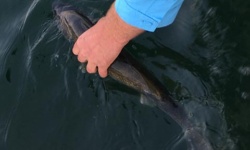I had every intention of writing about house finches for this blog, but then something momentous happened on May 28.
When people think of epic spring migration in North America they tend to think of High Island in Texas or Magee Marsh in Ohio or even Point Pelee, Canada. However, an eBird list coming out of Observatoire d’Oiseaux in Tadoussac, Quebec is blowing everyone’s mind today. It’s got people planning trips for 2019.
Here’s the link to the quite possibly the greatest one-day bird list for a location of all time.
In case anyone doubts the totals of warblers being reported – because let’s face it, seeing over 100,000 Cape May warblers in a day sounds a little far fetched – it is real. The list is from Ian Davies, project coordinator for Cornell Lab of Ornithology’s eBird.
Many are now wondering, “How did this happen, and should I skip all bird festivals and just hang out in Tadoussac next spring?” This is a good spring migration spot, especially if you missed warbler migration where you live and want to make a last-ditch effort for late spring. Birds in the final stretch to reach their breeding grounds congregate there, plus the surrounding boreal forest will give you a shot at species like boreal owl and black-backed woodpecker. It’s also a good spot to see beluga whales.
Observatoire d’Oiseaux can be amazing anytime, but a confluence of factors came together for this recent event. Southwest winds had pushed birds in and then it rained right at dawn. When the rain stopped and the sun came out, migrating birds realized that they were not where they wanted to be; they had gone too far north and used the land features to reorient themselves.

Observatoire d’Oiseaux in Tadoussac, Quebec, can be amazing anytime, but a confluence of factors came together for this recent event.
Many of the birds were coming from the northeast to head southwest, which is opposite of where you might think birds should fly for spring migration. This is a phenomenon known as “morning flight.” I’ve seen it a few times, only on a much smaller scale. Sometimes you might notice large flocks of waterfowl flying south in the morning when lakes are still frozen. Those birds came overnight then noticed that there’s no open water. They need to find it so they turn around and head back south.
One morning after a good south-wind spring migration night, my husband and I had to be up at dawn for an event and headed to a 24-hour diner near the Mississippi River. Over breakfast we watched a nonstop movement of northern flickers heading south the entire time.
There’s a Facebook group dedicated to studying morning flight that can give you some insight on the types of weather conditions to monitor in your area. People also share photos and videos. There’s a spectacular video (above) of blue jays flying over Whitefish Point Bird Observatory in Michigan.
So take a moment to relish that eBird list. It boasts over 700,000 warblers in a day. You can wonder as my friend Joe Lindell did: “Have I seen that many birds in my entire life?

![Birding world a-Twitter over a grand convergence at Tadoussac, Quebec [video]](https://jrproteam.com/wp-content/uploads/2018/05/Magnolia-warbler-500x490.jpg)




